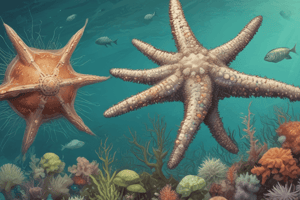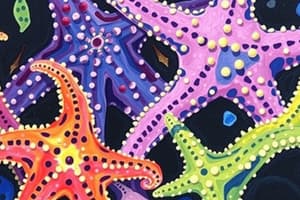Podcast
Questions and Answers
Which of the following organisms fall within the phylum Echinodermata? (Select all that apply)
Which of the following organisms fall within the phylum Echinodermata? (Select all that apply)
- Sea cucumbers (correct)
- Sea urchins (correct)
- Sea lilies (correct)
- Sea stars (correct)
What kind of environment do echinoderms live in?
What kind of environment do echinoderms live in?
Marine
How old is this lineage?
How old is this lineage?
About 600 mybp
The number of extant species of echinoderms is _____ and extinct species is _____
The number of extant species of echinoderms is _____ and extinct species is _____
What keeps echinoderms isolated to only marine environments?
What keeps echinoderms isolated to only marine environments?
What is the endoskeleton of echinoderms made of?
What is the endoskeleton of echinoderms made of?
What are the individual plates of calcium carbonate called?
What are the individual plates of calcium carbonate called?
What happens when ossicles fuse together?
What happens when ossicles fuse together?
What does it mean to have a true coelom?
What does it mean to have a true coelom?
What does it mean to be a deuterostome?
What does it mean to be a deuterostome?
What are the class names of the 5 major extant species of echinoderms? (Select all that apply)
What are the class names of the 5 major extant species of echinoderms? (Select all that apply)
What class is considered the out-group to the echinoderms?
What class is considered the out-group to the echinoderms?
Although echinoderms are considered bilateral animals, what type of symmetry do they have?
Although echinoderms are considered bilateral animals, what type of symmetry do they have?
The ____________ is oriented up. The ____________ is oriented down.
The ____________ is oriented up. The ____________ is oriented down.
What is the axis of symmetry known as and why is it called this?
What is the axis of symmetry known as and why is it called this?
What is the water vascular system?
What is the water vascular system?
Through what sieve-like structure does the water vascular system get water?
Through what sieve-like structure does the water vascular system get water?
Through what structure is the madreporite connected to the ring canal?
Through what structure is the madreporite connected to the ring canal?
What structure is squeezed in order for the tube feet to extend?
What structure is squeezed in order for the tube feet to extend?
Explain the reproduction of echinoderms.
Explain the reproduction of echinoderms.
How do these organisms affect ecology?
How do these organisms affect ecology?
What is the larvae of these organisms called?
What is the larvae of these organisms called?
Class: Asteroidea - What organisms fall into this class? (Select all that apply)
Class: Asteroidea - What organisms fall into this class? (Select all that apply)
How many known species are within the class Asteroidea?
How many known species are within the class Asteroidea?
What do organisms in the Asteroidea class prefer to feed on?
What do organisms in the Asteroidea class prefer to feed on?
How can you tell organisms from the Asteroidea class from other 'star-like' relatives?
How can you tell organisms from the Asteroidea class from other 'star-like' relatives?
How do organisms in the Asteroidea class digest their food?
How do organisms in the Asteroidea class digest their food?
Where can you find the gonads in a sea star dissection?
Where can you find the gonads in a sea star dissection?
What are papulae and where are they located?
What are papulae and where are they located?
What are pedicellariae and where are they located?
What are pedicellariae and where are they located?
Explain the nervous system of the Asteroidea class.
Explain the nervous system of the Asteroidea class.
Class: Echinoidea - What organisms fall into this class? (Select all that apply)
Class: Echinoidea - What organisms fall into this class? (Select all that apply)
Flashcards are hidden until you start studying
Study Notes
Echinodermata Overview
- Includes sea stars, sea urchins, sea lilies, and sea cucumbers.
- Exclusively marine organisms, unable to osmoregulate.
Evolutionary History
- Lineage dates back approximately 600 million years.
- Extant species count around 6,500; extinct species total about 13,000.
Body Structure
- Endoskeleton composed of calcium carbonate (CaCO3).
- Individual plates are called ossicles; when fused, they form a test.
- Possess a true coelom, meaning internal cavities and organs are lined with mesoderm.
Development and Symmetry
- As deuterostomes, the blastopore develops into the anus, leading to the anus forming before the mouth.
- Exhibit secondary pentaradial symmetry, reflecting five axes of symmetry.
Morphological Orientation
- The oral-aboral axis extends from mouth (down) to anus (up).
Water Vascular System
- A subdivision of the coelom used for locomotion, feeding, reproduction, and excretion.
- Water enters the system through a sieve-like structure known as the madreporite.
- The madreporite connects to the ring canal via the stone canal.
- Extension of tube feet is facilitated by squeezing the ampulla.
Reproductive Methods
- Primarily reproduce sexually with separate sexes, often via external fertilization.
- Asexual reproduction occurs when limbs are removed, provided 20% of the central disk remains.
Ecological Impact
- Echinoderms serve as food sources for various marine species.
- Certain species, like the Crown of Thorns sea star, can significantly damage coral reefs.
Larval Stage
- Larvae referred to as triarch larvae, indicative of their early developmental form.
Class: Asteroidea (Sea Stars)
- Approximately 1,500 known species.
- Prefer to feed on mollusks.
- Distinctive arms are broadly attached to the central disk, differing from other star-like relatives with narrower bases.
- Digestion involves externally protruding their stomachs to digest prey.
- Gonads located between digestive glands and ampulla.
- Papulae function as skin gills on the sea star's surface.
- Pedicellariae act as cleaning claws, also situated on the surface.
- Nervous system consists of a loose net with radial nerves and a nerve ring; can detect light but not see.
Class: Echinoidea (Sea Urchins, Sand Dollars, and Sea Biscuits)
- Not detailed in the provided text but is part of the broader Echinodermata phylum.
Studying That Suits You
Use AI to generate personalized quizzes and flashcards to suit your learning preferences.




